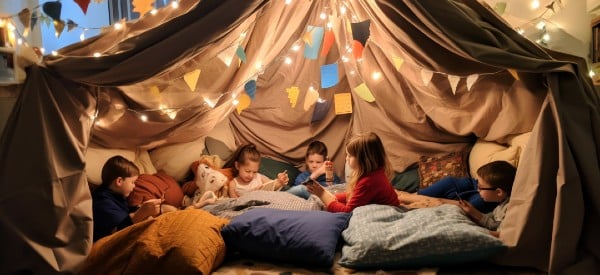Are you tired of endless tantrums and restless afternoons? Look no further! We’ve got the ultimate guide to quiet time for kids.
Quiet time is not only a chance for your little ones to recharge, but it’s also crucial for their overall development.
In this article, we’ll share proven strategies and tips to help you navigate the transition from nap time to quiet time, establish a calming routine, create the perfect environment, and keep your kids engaged during this precious downtime. We will also look at some of our favorite quiet time activities for kids so you can help your little ones grow and learn even when not making a lot of noise around the house!
Get ready to master the art of quiet time!
What is Quiet Time for Kids

Quiet time can come in a variety of ways throughout the day, but this time is simply a period of time that consists of unstructured activities to help your little ones stay entertained without the need to be stimulated with physical activities or screen time.
I’ve found that quiet time works best for my preschool son when these activities occur in his room or in a designated area where he feels comfortable.
My son has come to love quiet time because it gives him a chance to wake up, relax, or wind down, depending on when he jumps into the quiet time activity.
After talking to other moms and dads in the neighborhood and at church about quiet time, I realized most parents feel confident about quiet time for their preschoolers.
I put this post together to share my experience and thoughts about quiet time to help you and your little ones get the rest you all deserve while learning and entertaining themselves!
Benefits of Quiet Time for Kids

Quiet time promotes relaxation, reduces stress, enhances focus and concentration, encourages independent play and creativity, improves self-regulation and emotional well-being, and supports learning cognitive and social development in preschoolers.
Incorporating regular quiet time into a child’s routine can have numerous benefits for their overall well-being.
1. Child Can Unwind
During quiet time, children have the opportunity to unwind and relax, allowing their bodies and minds to rest.
This can help reduce stress and promote a sense of calmness. Additionally, quiet time encourages independent play, allowing children to explore their interests and engage in imaginative activities. This promotes creativity and helps develop problem-solving skills.
2. Practice Self-Regulation
Quiet time provides an opportunity for children to practice self-regulation as they learn to manage their own behavior and emotions without constant guidance or interaction from adults.
This can lead to improved emotional well-being and a greater sense of autonomy.
3. Cognitive Development
In terms of cognitive development, quiet time allows children to focus and concentrate on their chosen activities.
This can enhance their ability to maintain attention and improve their concentration. Additionally, independent play during quiet time helps stimulate cognitive growth by encouraging problem-solving, decision-making, and critical thinking.
4. Social Development
Lastly, quiet time supports social development by allowing children to engage in solitary play and self-reflection.
This can foster self-awareness and a sense of independence while also promoting social skills such as empathy and self-control.
When Should I Introduce Quiet Time For My Child?

Quiet time can be introduced into your regular routine at any time, and we started having my son work on quiet activities around the age of three years old. At the beginning, it was challenging to get my son to enjoy quiet time activities, but over time he started to look forward to the silent activities throughout the day.
When my son approached age four, I started to develop an early-morning routine of quiet time play for when my son woke up in the early morning. Instead of watching T.V., I encouraged him to build blocks or colors to give my husband and me more time to sleep before we all woke up.
I talked to several parents in the neighborhood, and I found that their routine looked a little different than our routine, but in general, quiet time was used for preschoolers to keep young learners engaged at different times of the day without the need for screentime activities.
I mention this just to say that your child’s quiet time activities and even your whole family’s routine will look different than the one we have in my house.
But I think it is safe to say that you can introduce quiet time for your child as early as three years old and build a consistent routine to help your little ones grow into a predictable, quiet time routine.
Transitioning From Nap Time To Quiet Time

I used to love the precious hours my son would nap during the day. This time felt like recess at school when I could take a nap or focus on work or chores around the house.
But then, one day, naps went away. I was worried that I would love the ability to find time for myself to recharge, but then I found that I use quiet time to engage in those activities without the need for my son to be physically sleeping.
When transitioning from nap time to quiet time, it’s important to establish a consistent schedule and clear boundaries.
Nap time is a period of rest and rejuvenation for young children, but their need for sleep decreases as they grow older. This is where quiet time comes in, providing a structured and calm period for independent activities.
During this transition, setting a specific time for quiet time activities and communicating it to your child is essential. This will help them understand the change in routine and adjust accordingly.
During this time, encourage your child to engage in quiet activities such as reading, drawing, or playing with puzzles. By incorporating these activities, you are fostering their creativity and autonomy.
It may take some time for your child to adapt to this new routine, so be patient and supportive throughout the process.
In the next section, we will delve into the importance of establishing a quiet time routine and the benefits it brings to your child’s development.
Establishing a Quiet Time Routine

To establish a consistent routine for independent play, start by setting clear boundaries and communicating a specific time for your child’s quiet activities.
Here are four steps to help you establish a quiet time routine for your younger child:
- Create A Designated Quiet Time Area: Set up a unique space in your child’s room or a designated play area where they can engage in quiet activities. To encourage independent play, fill it with books, puzzles, and quiet time toys.
- Set A Regular Schedule: Choose a specific time each day for quiet time, such as after lunch or in the afternoon. Consistency is key to help your child understand and anticipate their quiet time.
- Communicate Expectations: Clearly explain to your child what quiet time is and what they can do during this period. Encourage them to engage in activities that promote relaxation and calmness.
- Provide Gentle Guidance: You may need to sit with your child during quiet time to help them get used to the routine. Gradually, give them more independence and encourage them to engage in independent play.
- Encourage Independent Play: Initially, you may need to provide some guidance and suggestions for activities during quiet time. Encourage your child to choose activities that they enjoy and that promote their independence and creativity.
Setting up a quiet time routine for your child is more than just carving out moments of peace. It’s about teaching self-regulation, encouraging independence, and providing a structured time for imagination or learning to flourish.
A successful quiet time routine benefits your child and the entire family.
Create a Calming Environment for Quiet Time

Kids are naturally energetic, and if your little ones are anything like my son, it can sometimes be difficult to have them focus on a single task. I found that my son accepts quiet time activities more when quiet time is conducted in an environment without distractions.
Creating a calming environment during quiet time can include soft lighting, cozy blankets, soothing music, or a favorite story in an audiobook. It is essential to provide a serene and peaceful atmosphere to promote relaxation and tranquility for kids during this time.
- Soft lighting, such as dimmed lamps or fairy lights, can create a cozy and calming ambiance in the room.
- Cozy blankets or pillows can provide a sense of comfort and security, allowing children to feel safe and relaxed.
- Playing soothing music or nature sounds can enhance the calming environment and help children unwind.
Creating a calming environment and offering quiet activities can provide children a much-needed break, promoting relaxation, reducing stress, and enhancing their overall well-being.
Engaging Activities for Quiet Time
Engage your child in quiet activities during their designated quiet time. Here are four enjoyable and relatable activities to consider:
- Legos: Encourage your child to use their imagination and build creative structures with Lego blocks. Legos promote fine motor skills and problem-solving abilities.
- Coloring Books: Provide your child with coloring books and a variety of coloring materials. Coloring helps develop hand-eye coordination and allows children to express their creativity.
- Puzzles: Introduce age-appropriate puzzles that challenge your child’s problem-solving skills. Completing puzzles boosts cognitive development, spatial awareness, and patience.
- Playtime: Allow your child to engage in open-ended play with their favorite quiet time toys. This unstructured play encourages imagination, social skills, and independent thinking.
These activities not only provide entertainment but also offer numerous developmental benefits. Engaging in quiet activities during designated quiet time helps children relax, focus, and develop important skills. So, make sure to incorporate these activities into your child’s quiet time routine for a well-rounded and enriching experience.
Tips for Encouraging Independent Play During Quiet Time
If you want to encourage your child to play independently during quiet time, try providing them with open-ended toys and activities that spark their imagination.
During this daily routine of alone time, it is important to create an environment that promotes independent play. Open-ended toys, such as building blocks, dolls, or art supplies, allow children to engage in imaginative and creative play without specific instructions or limitations.
These types of quiet time toys give children the freedom to explore and use their imagination, which is crucial for their cognitive and social development.
In addition to open-ended toys, you can also incorporate activities that encourage independent play during quiet time.
For example, setting up a quiet reading corner with a variety of books or creating a sensory play station with materials like playdough or water can provide hours of entertainment and stimulation for your child.
- Start Small: Start with just a few minutes of quiet time and gradually increase the duration as your child becomes more comfortable. This gradual approach helps them ease into the routine and build a positive association with quiet time.
- Set A Pre-Determined End: To ensure a smooth transition, make sure to choose a specific end time for your child’s quiet time. Having a predetermined end time helps create structure and predictability for your child. It also helps them understand that quiet time has a defined duration.
- Build A Dedicated Area: Creating a designated space helps establish a dedicated area for your child’s quiet time. This space should be comfortable and inviting, allowing your child to relax and engage in quiet activities. Consider using a cozy corner in their room or setting up a small play area with a soft rug and cushions.
- Have Toys Just For Quiet Time: Make sure you have special toys that are only used during quiet time to keep your child engaged and excited. Having designated toys for quiet time can help create a sense of novelty and anticipation, making the quiet time experience more enjoyable for your child.
- Layout Snacks & Water: Now that we have discussed the importance of having special toys for quiet time, let’s move on to another essential aspect of creating a successful quiet time routine: laying out snacks and water.
By providing your child with open-ended toys and activities, you are promoting their autonomy and fostering their creativity. This not only helps them develop important cognitive and social skills, but it also allows them to recharge and unwind during quiet time.
When To Use Quiet Time Activities For Kids

Before we dive into the discussion on when to use quiet time activities for kids, it’s important to understand the different key points that can benefit from incorporating quiet time into a child’s routine.
Research suggests that incorporating quiet time during these specific periods can provide much-needed rest, rejuvenation, and promote overall well-being for children.
1. Before I Wake Up
Afternoon quiet time is a great alternative to napping for kids who have outgrown their afternoon nap. It provides a period of rest and relaxation, allowing their bodies and minds to recharge.
During this time, children can engage in independent and quiet activities, creating a soothing and peaceful environment.
Imagine your child in a cozy room, surrounded by books and quiet toys, fully absorbed in their own world of imaginative play. They have the freedom to explore their creativity, make decisions, and develop important skills like problem-solving and self-regulation.
Quiet time also offers a chance for children to recenter and recharge, reducing crankiness and meltdowns. By establishing a daily habit of quiet time, you are providing your child with a valuable opportunity for growth and well-being.
2. Weekend Afternoons (Instead Of Naps)
On weekend afternoons, we can embrace the opportunity to provide our children with a period of rest and relaxation instead of naps.
Research shows that quiet time is beneficial for toddlers and preschoolers, allowing their bodies and brains to rest and slow down.
It also helps to promote creativity, autonomy, and emotional well-being. During this time, children can engage in independent play, read books, or participate in calming activities like drawing or listening to music.
It is important to establish a consistent routine for quiet time and gradually increase the duration. Visual aids, such as a visual timer or clock, can help children understand the length of quiet time.
3. After Exercise/ Going Outside
When you go outside and exercise, it’s important to remember to incorporate a period of rest and relaxation afterward.
This allows your body and mind to recover and rejuvenate. During this time, you can engage in calming activities that promote relaxation and reduce stress.
Taking the time to rest and relax after exercise is essential for your overall well-being. It gives your body a chance to recover and prepare for the next physical activity.
Now, let’s explore the importance of quiet time before bedtime.
4. Before Bedtime
Before bedtime, it’s crucial to establish a calming routine to help your child unwind and prepare for a restful sleep. Research shows that a consistent bedtime routine can promote better sleep quality and help your child transition smoothly into sleep.
Start by creating a predictable sequence of activities that signal it’s time for bed, such as brushing teeth, changing into pajamas, and reading a bedtime story.
This routine should be soothing and relaxing, avoiding stimulating activities or screens close to bedtime.
Creating a calm sleep environment with dim lighting, a comfortable temperature, and soft bedding can also enhance your child’s sleep experience. Following these steps and providing a consistent bedtime routine can help your child unwind and prepare for a restful night’s sleep.
Help Your Child With Quiet Time!
Implementing quiet time for toddlers and preschoolers is essential for their overall well-being. It allows their bodies and minds to rest and recharge, promoting healthy development.
Parents can adapt to their child’s changing sleep needs by transitioning from nap to quiet time. Establishing a consistent routine and creating a calming environment are key factors in making quiet time successful.
Engaging in activities and encouraging independent play during this time can foster creativity and independence. Despite challenges, maintaining consistency in quiet time will reap long-term benefits.
So, why not give your child the gift of quiet time and watch them thrive?







0 Comments